

FOI 25/26-0078 - DISCLOSURE LOG
DOCUMENT 1
The contents of this document are OFFICIAL
APS6 Planner
Internal Position Description
Table 1: Primary details of position
Heading
Details
Job title
NDIA APS6 Planner
Classification
APS6
Location
Various Locations
Reports to
EL1 Assistance Director
Supervisory
None
Responsibility
Role Purpose
The Complex Support Needs Branch provides specialised support for people with
disability with additional complexity due to situational and personal factors. Roles
within the branch may sit within the following teams:
•
Complex Support Needs (CSN): supports participants who are in the CSN
Pathway providing planning, close monitoring, and intensive implementation
to stabilise the participant’s circumstances.
•
Children and Young People (CYP): the CYP team provides specialised
support to NDIS child participants. The team works collaboratively to provide a
'wrap-around' service for the child or young person, and their family. CYP
team focus is on an early intervention and prevention approach that supports
children and young people to access the disability supports they need during
OFFICIAL
ndis.gov.au
Page 1 of 54
1
FOI 25/26-0078 - DISCLOSURE LOG
OFFICIAL
key life stages and transition points. The CYP team works closely with other
CSN Branch teams, State and Territory Government colleagues and providers
to ensure a holistic and goal focussed service that meets the needs of the
children and families we support.
•
Short Term Response: aims to provide participants time sensitive, intensive
support and close monitoring over a short period (16 weeks) to stabilise the
participants circumstances as a short-term early intervention mechanism.
•
Specialised Resolution Team: are a national team providing support to
participants in the Complex Support Needs (CSN) and Aged Care Hospital
Interface (ACHI) Branches. The primary focus is ensuring participant
safeguards and promoting a positive participant experience. The team works
to address and resolve any complex issues or challenges that may arise,
utilising expertise and specialised knowledge.
•
Justice Planning Team: provides support to participants who intersect with
the justice system, with the aim of ensuring participants have the disability
supports they require whilst in custody, and to enable informed transition to
the community.
•
Justice Liaison: are a national team providing timely and effective support to
internal and external stakeholders working alongside people with disability
who intersect with the justice system. Our aim is to ensure people with
disability have the disability supports they require whilst in custody, and to
support successful transition to the community.
•
Operations: supports the CSN branch through workforce planning, capability
and onboarding staff, along with referral to and from the Complex pathway,
nationalised planning support and managing escalations.
Why your role matters
•
Empower Lives: Your role provides specialised support to NDIS participants
with complex needs, ensuring they receive the necessary disability supports
to enhance their capacity and achieve their NDIS goals.
•
Collaborate for Success: By working closely with other teams, internal and
external stakeholders, you contribute to a holistic, goal-focused service that
meets the diverse needs of participants and their representatives.
OFFICIAL
ndis.gov.au
Page 2 of 54
2

FOI 25/26-0078 - DISCLOSURE LOG
OFFICIAL
Duties and responsibilities
The APS6 Planner wil work within the CSN Planning Teams, supporting
participants with complex needs. The team has a national approach and has a
high level of engagement with internal and external stakeholders.
The position wil have a considerable level of public contact in relation to
complex, difficult or sensitive issues. It is required to liaise with a range of internal
and external stakeholders in a representational role on behalf of the
branch/division/NDIA.
The APS6 Planner performs team leadership and management responsibilities,
setting priorities and managing team workflows. The position is required to
detailed technical, professional, policy, and operational support and advice for
complex problems. Coordinate and assist in strategic planning, program and
project management, and policy development to support the NDIA’s objectives of
building a world-leading National Disability Insurance Scheme.
The APS6 Planner has reasonable level of autonomy and accountability,
exercising initiative and judgement to interpret legislation and policy, and applying
practices and procedures to achieve outcomes.
Duties and responsibilities include but are not limited to:
• Work with a caseload of participants end to end process, using a person-
centred approach, focusing on capacity building, regular monitoring, and
progress tracking.
• Provide detailed technical, professional, policy, and operational support and
advice regarding complex participant needs to participants and stakeholders.
• Support participants and stakeholders to navigate the planning process.
• Gather information from participants, their representatives, and multiple
stakeholders to enable high-quality planning and evidence-based decision-
making.
• Determine funded supports to be included in participant NDIS plans,
approving or declining NDIS funded supports.
• Work closely with participants and their representatives to identify current and
future supports, including informal, mainstream, and community support
options, to achieve plan outcomes.
OFFICIAL
ndis.gov.au
Page 3 of 54
3

FOI 25/26-0078 - DISCLOSURE LOG
OFFICIAL
• Resolve issues, mitigate risks, and handle complaints related to participants
and their NDIS plans.
• Complete administrative tasks related to participant records, send internal
referrals/requests to other areas, and manage task workflows.
• Provide guidance and advice regarding NDIS processes and framework,
including clarifying jurisdictional processes, roles, interfaces, and
responsibilities.
• Collaborate with team members and assisting to develop specialised
knowledge in areas of expertise.
• Work in partnerships with team members; coach as well as mentor new staff,
monitor team capacity and workflow activities. Contribute to quality
improvement activities to enhance service delivery practice, processes, and
systems.
Note: the key responsibilities of the role are based on current priorities and may
change over time.
Skills required for the position
Skil s required include:
• Ability to analyse complex problems and develop effective solutions.
• Capability to set priorities, oversee workflows, meet deadlines and deliver
outcomes.
• Strong verbal and written communication skil s to communicate with
stakeholders and team members.
• Strong liaison skil s for interacting with external stakeholders, internal staff,
and management team.
• Building customer loyalty to meet and exceed internal and external customer
expectations while cultivating relationships that secure commitment and trust.
• Competence in using office software (e.g., Microsoft Office Suite) and other
relevant tools for scheduling, document preparation, and communication.
• Competence in using PACE.
• Exercise initiative and sound judgement in interpreting legislation and policy.
OFFICIAL
ndis.gov.au
Page 4 of 54
4


FOI 25/26-0078 - DISCLOSURE LOG
OFFICIAL
• Planning and organising action plans for self and others to complete work
efficiently and on time by setting priorities, establishing timelines, and
leveraging resources.
Note: The NDIA has a capability framework aligned to t
he Australian Public
Service (APS) Work Level Standards. Please refer to the APS6 classification.
Knowledge required for the position
Knowledge required includes:
• Understanding the objectives of the National Disability Insurance Agency
(NDIA) and the National Disability Insurance Scheme (NDIS).
• Ability to build knowledge and understanding of State and Territory
Government sectors mainstream services.
• Familiarity with relevant legislation, regulations, and policy frameworks that
govern the NDIA and NDIS operations.
• Knowledge of procedures and good record-keeping.
• Expertise in providing technical, professional, and operational support.
• Awareness of communication protocols and etiquette for interacting with
internal and external stakeholders.
• Understanding of confidentiality and privacy principles to handle sensitive
information appropriately.
Qualifications and/or Experience
Desirable qualifications and experience include:
• Desirable qualifications in related field or comparable discipline or experience
working in related are not mandatory but desirable.
OFFICIAL
ndis.gov.au
Page 5 of 54
5

FOI 25/26-0078 - DISCLOSURE LOG
OFFICIAL
Working Conditions
Working conditions include:
• Working in an open office environment (exposure to general workplace
chatter).
• Working from home on occasion.
• Working in a hot desk environment.
• Significant periods of sitting at a counter or desk.
• Operating a telephone.
• Computer/screen-based work.
• Ability to use computer/software applications including Microsoft Office and
NDIA business systems.
• Assistance animals may be in the work area.
• Attendance at external locations offsite.
• Performing high levels of phone usage and/or face to face work.
• Driving a vehicle to attend external locations which are not otherwise
accessible by public transport.
OFFICIAL
ndis.gov.au
Page 6 of 54
6
FOI 25/26-0078
- DISCLOSURE LOG
DOCUMENT 2
OFFICIAL
Attachment A: CSN referral and process
In response to FOI SEARCH CONSULT – FOI 24/25-1964
CSN Referral Process
The referral of a NDIS participant to the Complex Support Needs (CSN) branch and
its specialised planning pathways are an internal only process typical y completed by
a state-based service delivery delegate.
In the context of the NDIS, complex support needs are defined as a situation where
a person has extraordinary support needs based on the presence of situational and
personal factors that demand a greater need for coordination of multiple services.
When submitting a referral to the CSN pathway for a NDIS participant the delegate
must identify the following situational and personal factors and note them in the CSN
Referral for Assessment Form (
see Attachment B CSN Referral for Assessment
Form).
• Accommodation:
o Risk to homelessness
o Children living outside of the family home or in immanent need for
outside accommodation.
• Disability
o Multiple and complex disability diagnosis
o Multiple family members with a disability
• Engagement with government services
o Voluntary or involuntary involvement in other government service
systems. In particular health, child protection, guardianship orders,
mental health and justice that impact the participants ability to engage
with the NDIS.
• Vulnerability and risk
o increased risk of significant harm from abuse or neglect
o impact of trauma or abuse
o limited or no expressive communication.
• Support and care
o Limited or no informal supports (for example, advocate, guardian,
nominee) and informal support (for example, family member, carer,
friend support) to assist with decision making or engaging in planning.
o Transitional supports for returning to the community (for example
leaving rehabilitation or hospital, incarceration)
OFFICIAL
ndis.gov.au
Page 7 of 54
FOI
25/26-0078 - DISCLOSURE LOG
OFFICIAL
o Stressed care arrangements. An immediate unmet need for targeted
support or a crisis situation due to a sudden unexpected change in the
person’s circumstances.
• Provider Market
o The ability for the provider market capacity to support people
o Limited or no services available in the participants area
o Thin or exhausted markets in regional and remote areas.
The referral form is submitted for assessment through the PACE business system.
PACE is the customer relationship management tool used by the NDIA to manage
the interactions and planning with participants.
OFFICIAL
ndis.gov.au
2
Page 8 of 54
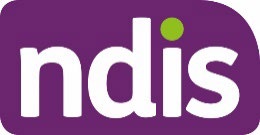
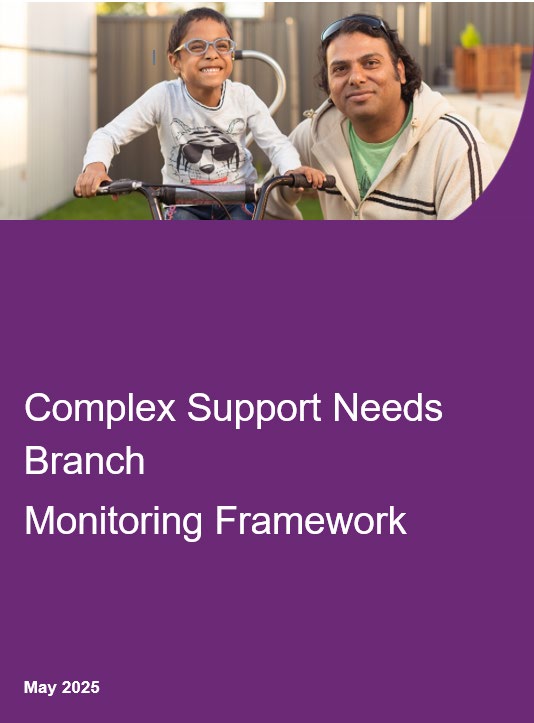
FOI 25/26-0078 - DISCLOSURE LOG
DOCUMENT 3
OFFICIAL
July 2025
ndis.gov.au
Page 9 of 54
link to page 11 link to page 11 link to page 12 link to page 14 link to page 17 link to page 18 link to page 19 link to page 20 link to page 22 link to page 22 link to page 23 link to page 23 link to page 23 link to page 23 link to page 24 link to page 26 link to page 26 link to page 26 link to page 27 link to page 29 link to page 29
FOI 25/26-0078 - DISCLOSURE LOG
OFFICIAL
Contents
Complex Support Needs Branch (CSN) Monitoring Framework ................................ 3
1. Purpose .................................................................................................................... 3
2. Monitoring Cycle ..................................................................................................... 4
3. Monitoring Activities and Check-in Definitions .................................................... 6
4. Monitoring Activities and Check-in Approaches .................................................. 9
4.1. Initial Contact .................................................................................................. 10
4.2. Implementation Meeting .................................................................................. 11
4.3. Check-in Types ............................................................................................... 12
5. Record Management for Monitoring Activities ................................................... 14
6. Feedback ................................................................................................................ 14
7. Version Control ..................................................................................................... 15
Appendix A .................................................................................................................... 15
Justice Interface ...................................................................................................... 15
Justice Planning Team Monitoring .......................................................................... 15
Justice Liaison Team Monitoring ............................................................................. 16
Appendix B .................................................................................................................... 18
Specialised Resolution Team (SRT) Monitoring Guidance ..................................... 18
Specialised Resolution Team (SRT) Monitoring ...................................................... 18
Short Term Response (STR) Team Monitoring ....................................................... 19
Appendix C .................................................................................................................... 21
Stages of Monitoring and Check ins From Plan Approval ....................................... 21
V2.1 2025-07-08
CSN Monitoring Framework
Page
2 of
22
OFFICIAL
Page 10 of 54
FOI 25/26-0078
- DISCLOSURE LOG
OFFICIAL
Complex Support Needs Branch (CSN) Monitoring
Framework
1. Purpose
This Framework wil guide you to:
•
Understand the CSN approach to plan monitoring.
•
Understand the different types of monitoring activity that a planner is to complete
and record appropriately on PACE.
•
Consider the participant circumstances to be addressed during monitoring.
•
Determine how to document the monitoring activity.
The Framework should be used by:
•
Delegates, including CSN Planners, Resolution Officers
•
Liaison Officers
•
CSN Participant Support Officers (PSOs)
This document should be read in conjunction with the CSN Monitoring Work Instructions
document on CSN SharePoint,
CSN Service Model.
CSN supports participants with unique and significant needs arising from personal and
situational factors as well as ensuring these participants receive tailored, coordinated, and
responsive service delivered through a caseload management approach. One of the key
components of the CSN service offer is regular monitoring of a participant’s plan from initial
allocation.
Monitoring in CSN is a
proactive, structured, and participant-centred process designed to ensure that individuals with complex needs receive the right supports at the
right time. It is a
core function of the CSN service offer and is essential for safeguarding
participant outcomes, identifying emerging risks, and ensuring that NDIS plans are
implemented effectively.
The
purpose of monitoring is to ensure that participants with complex needs are
receiving the right supports, at the right time, in the right way. Monitoring is not just
about oversight—it's a proactive, participant-focused process that helps maintain the
quality, safety, and effectiveness of funded, community and mainstream supports. It is also
important for ensuring that:
V2.1 2025-07-08
CSN Monitoring Framework
Page
3 of
22
OFFICIAL
Page 11 of 54
FOI 25/26-0078 - DISCLOSURE LOG
OFFICIAL
You ensure plan implementation aligns with the participant’s goals and needs.
You identify and respond to changes in the participant’s circumstances.
You foster collaboration among stakeholders, including support coordinators, guardians,
other government services and service providers.
You facilitate timely responses and changes to supports where necessary.
You evaluate the need for transition to other planning teams, such as Service Delivery, MND
or Justice Planning teams.
2. Monitoring Cycle
The
CSN Monitoring Cycle is a continuous process designed to ensure consistent
oversight and support throughout the duration of a plan. It is recommended that a
monitoring activity occurs
at least every six weeks and a Scheduled Check-in occurs
every 6 months, while a participant is supported within CSN. A delegate or liaison officer’s
engagement may be
more frequent based on the participant’s level of risk, involvement
with the justice system, child protection, health, or other situational factors.
V2.1 2025-07-08
CSN Monitoring Framework
Page
4 of
22
OFFICIAL
Page 12 of 54
link to page 23
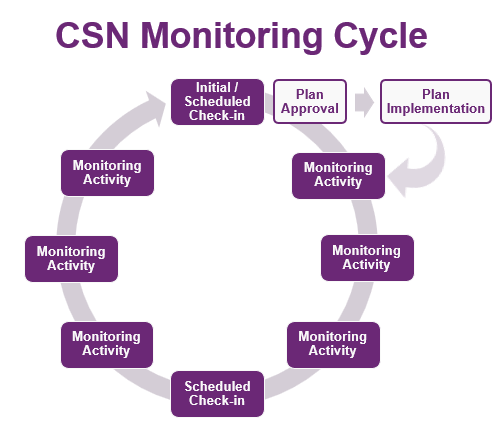
FOI 25/26-0078 - DISCLOSURE LOG
OFFICIAL
Image caption: The CSN Monitoring Cycle for a Participant where 6 weekly monitoring
activities are performed. The cycle follows a structured, clockwise sequence of steps that
repeat over time.
Where the Participant is engaged with an alternate pathway in CSN, the following advice
should be considered:
Justice Interface
The
Justice Planning and
Liaison Teams within CSN provide a specialised service for
participants involved in the justice interface, incorporating a tailored and responsive
approach to monitoring. For more information on monitoring and check-in approaches for
participants supported by the Justice Liaison and Planning teams, please refer to
Appendix A.
Specialised Resolution Team (SRT)
The Specialised Resolution Team (SRT) is a dedicated team that provides a divisional
response for at risk participants. For more information on SRT monitoring and check-in
approaches please refer to Appendix B.
Child Protection Liaison (CPL)
V2.1 2025-07-08
CSN Monitoring Framework
Page
5 of
22
OFFICIAL
Page 13 of 54
FOI 25/26-0078 - DISCLOSURE LOG
OFFICIAL
The Child Protection Liaison (CPL) is a time limited pilot initiative aimed at enhancing
outcomes for children, young people and their families. The project wil test the concept of
CPL roles within selected cohorts in Western Australia (WA) and Victoria (VIC). The initial
trial period will commence in August 2025 and run for a 12-month period before an
evaluation phase. If successful, the intention would be to expand the service offer across
other states and territories.
The CPL wil not undertake participant check-in activities as outlined in Check-in
Approaches. The role of the CPL is to provide an important link between external
stakeholders supporting people with disability interfacing with the child protection system
and the NDIA. This support is provided regardless of the pathway the participant is aligned
to. The CPL wil work collaboratively with internal staff to ensure all relevant information
and contact is recorded in line with PACE Knowledge Articles.
3. Monitoring Activities and Check-in Definitions
Monitoring is not a single action but a range of purposeful engagements that provide
insight into how wel a participant’s plan is providing support to achieve goals and improve
the quality of their life.
These may include:
Activity
Key Purpose
Initial Contact
Establishing rapport and understanding the participant’s immediate
needs upon entry into the CSN pathway.
Initial contact is the foundational part of the monitoring framework
because it marks the beginning of active oversight and engagement
with the participant (and/or their guardian). While it may seem
introductory, it plays a critical role in setting up expectations of
support and to inform of the regular monitoring activities that will
occur throughout the participant’s journey in the CSN pathway.
For more information on participant allocations, please refer to
Knowledge Article
manage a new participant allocation.
Implementation This is a structured opportunity to review plan implementation
Meeting
activity and set the scene with stakeholders on the expectations of
V2.1 2025-07-08
CSN Monitoring Framework
Page
6 of
22
OFFICIAL
Page 14 of 54
OFFICIAL
FOI 25/26-0078 - DISCLOSURE LOG
Activity
Key Purpose
services and, wil also identify any risks that may be present. A plan
implementation meeting allows for coordination among stakeholders
to ensure supports are effective and aligned with the participant’s
goals.
It is also an opportunity to inform stakeholders of the monitoring
activities that wil occur as part of the CSN service offer and arrange
for any required assessments or progress reports to be submitted
within required timeframes.
The meeting should be offered within
7 calendar days of plan
approval. For further information relating to plan implementation
processes refer to Knowledge Article
understanding implementation
meetings.
Scheduled
Is a planned and regular point of contact between CSN and the
Check-in
participant (or their support network) to monitor how their NDIS plan
is progressing and, to assess participant wellbeing.
A Scheduled Check-in can be conducted via phone, Ms Teams call,
or in person, depending on the participant’s needs and preferences.
They may involve the participant directly, or their guardian, plan
nominee, or Support Coordinator.
It is a requirement of the monitoring framework that a
Scheduled
Check-in occurs every
6 months.
Discretionary
A Discretionary Check-in (including system generated risk flag) is
Check-in
flexible, unscheduled engagement initiated in response to specific
concerns, changes in a participant’s circumstances, or through your
own judgment where additional contact is needed. A discretionary
check-in may be required to respond quickly to emerging risks or
issues (e.g. a breakdown in supports, hospitalisation, housing
instability).
V2.1 2025-07-08
CSN Monitoring Framework
Page
7 of
22
OFFICIAL
Page 15 of 54
FOI 25/26-0078 - DISCLOSURE LOG
OFFICIAL
Activity
Key Purpose
Transition
Assessing whether the participant’s support needs have stabilised
Suitability
and, whether they are ready to move from CSN to a different
Reviews
support model such as Service Delivery.
This can occur at any stage within the CSN Monitoring Cycle and at
a minimum at every scheduled check-in. When it is assessed that a
participant may no longer meet the criteria for the CSN planning
pathway, it may be appropriate to consider a transition back to Core
Service Delivery. Refer to
transition referrals for more information.
Desktop Review A desktop review is a type of monitoring activity that involves
reviewing a participant’s information and progress without direct
contact with the participant or their support network. It can typically
be conducted by examining available documentation and PACE
records to assess the participants current plan and goal progression.
For more information on how to perform
a desktop review.
Stakeholder
Usually intentional, collaborative communication between CSN staff
Engagement
and key individuals or organisations involved in a participant’s
support network. This can include Support Coordinators, guardians,
plan nominees, service providers, other government agencies and
other relevant professionals.
What Monitoring is Not
It’s important to recognise monitoring activities from administrative or procedural activities
that do not directly provide information of a participant’s progress. These activities are
important for the participant to access supports and are not counted as monitoring
activities:
• Processing claims or payments
• Creating a Request for Service (RFS)
• Internal escalations or consultations
• Receiving or reviewing quotes
V2.1 2025-07-08
CSN Monitoring Framework
Page
8 of
22
OFFICIAL
Page 16 of 54
OFFICIAL
FOI 25/26-0078 - DISCLOSURE LOG
• Application for Assistive Technology, Vehicle Modifications, Home Modifications,
or Home and Living supports
• Contacting stakeholders solely to gather evidence
• Updating participant contact details in PACE
Monitoring is a
broader category that includes any action taken to assess how well a
participant’s NDIS plan is being implemented and if it continues to meet their needs.
Monitoring activities are intentional, documented, and outcome focused. They contribute to
the formal oversight of the participant’s plan.
A
check-in is a
type of monitoring activity - usually a
direct engagement with the
participant or their support network to gather updates, assess wellbeing, or follow up on
specific issues. These include scheduled check-ins
(6 monthly), and discretionary check-
ins (as needed).
4. Monitoring Activities and Check-in Approaches
Throughout the CSN monitoring process a CSN planner wil be required to undertake
monitoring activities and check-ins. Below is a table summarising the differences.
Feature
Monitoring Activity
Scheduled Check-in
Frequency
Every 6 weeks
Every 6 months
Formality
Can be informal
Formal and structured
Contact Required
Not always
Yes, direct contact
Purpose
Ongoing oversight
Comprehensive review
Documentation
Required (PACE Enquiry
Required (PACE Check-in
case and / or Activity Log)
case)
Examples
Desktop review,
Phone/Ms Teams/in-person
stakeholder contact
check-in
Guidelines for Engagement
To support meaningful and effective engagement, staff undertaking monitoring should
consider the following when speaking with the participant and their support network:
•
Be Participant Centred - this approach focuses on the individual's needs,
preferences, and goals, rather than just their disability or diagnosis. By placing the
V2.1 2025-07-08
CSN Monitoring Framework
Page
9 of
22
OFFICIAL
Page 17 of 54
FOI 25/26-0078 - DISCLOSURE LOG
OFFICIAL
individual at the centre of the care planning process, person-centred practice
empowers participants to take an active role in decision-making and ensures that
the support services provided are tailored to their unique needs and circumstances.
•
Promote Self-Advocacy by providing participants (or if a child their child
representative) with the knowledge, skil s, and confidence to advocate for
themselves, this can assist participants to take control of their lives and make
informed decisions about their care. This, in turn, promotes autonomy, self-esteem,
and overall well-being.
•
Review the participant’s PACE record and supporting documents before making
contact (complete a desktop review). Familiarise yourself with their circumstances
and supports.
•
Introduce yourself to the participant and their informal/formal supports.
•
Confirm your understanding of the participant’s background and existing information
held by the NDIS.
•
Discuss the participant’s individual circumstances, including informal, community,
and mainstream supports.
•
Ask how the funded supports in the participant’s plan are helping them pursue their
goals.
•
Enquire how the participant is managing their plan budget.
•
Ensure the participant and their support network understand and can access the
supports in the plan.
•
Respond to any open queries or outstanding requests from the participant.
•
If needed (or applicable to the participant), request that the Support Coordinator or
Specialist Support Coordinator assist in linking the participant to appropriate
services.
•
Advise the participant that regular check-ins wil occur and that their Support
Coordinator will provide ongoing updates to the NDIA.
•
Take a multi-disciplinary approach with the participants consent, collaborate with
the participants support ecosystem, both informal, formal and mainstream. By
working together with a range of professionals, including healthcare providers,
therapists, and support workers, support coordinators can ensure that individuals
with disabilities receive comprehensive and coordinated care that address their
complex needs and ensure everyone involved understands their roles and
responsibilities. Collaborative case conferencing.
4.1. Initial Contact
When a participant is allocated or re-assigned to a CSN Planner, initial contact must be
made:
•
Within 2 business days for priority al ocations, or
V2.1 2025-07-08
CSN Monitoring Framework
Page
10 of
22
OFFICIAL
Page 18 of 54
FOI 25/26-0078 - DISCLOSURE LOG
OFFICIAL
•
Within 5 business days for standard allocations.
This contact ensures the participant is aware they have a new My NDIS contact (CSN
Planner) and understand the role of the Complex Support Needs (CSN) Branch. The
interaction must be recorded in PACE as an enquiry case.
For more information on participant allocations, please refer to
manage a new participant
allocation.
To request assistance from CSN
Operations or
Participant Support Team (PIT) in
booking a meeting, please follow the steps outlined in
request a meeting booking in PACE.
Preparation Prior to Contact
Delegates are expected to conduct a
desktop review before initiating contact. Critical to
the desktop review is reading through the CSN Suitability Checker which gives a holistic
overview of the participant’s personal and situational factors. This review helps guide the
conversation and ensures the planner is informed about the participant’s background and
current supports.
4.2. Implementation Meeting
After a plan is approved, participants can start using the funding outlined in their NDIS plan
to access supports. This stage is called implementation, and it helps participants
understand and make the best use of their plan.
An
implementation meeting should be offered to support the participant (or their
guardian) in:
•
Gaining a clear understanding of their plan
•
Learn how to begin utilising their funded supports
•
Understand how their plan is managed and how payments are made
•
Connect with service providers of their choice
•
Understand the purpose and function of service agreements
This meeting also provides an opportunity to
identify any risks the participant may face
when using their funding.
Once a plan approval case is finalised, a
plan implementation case is automatically
generated in PACE. Where appropriate, the implementation meeting may be conducted at
the same time as the plan approval meeting. If not, the meeting should be offered within
7
calendar days of plan approval.
V2.1 2025-07-08
CSN Monitoring Framework
Page
11 of
22
OFFICIAL
Page 19 of 54
link to page 29
FOI 25/26-0078 - DISCLOSURE LOG
OFFICIAL
To request assistance from CSN
Operations or
Participant Support Team (PIT) in
booking a meeting, please follow the steps outlined in
request a meeting booking in PACE.
If the participant advises that an implementation meeting is not required, this decision must
be recorded in the implementation case on PACE. The next
scheduled check-in should
be booked within
six months.
For more information relating to the stages of monitoring within a participant’s plan, please
refer to
Appendix C.
4.3. Check-in Types
Check-in Overview
There are different types of Check-ins in PACE, which are explained below. For more
details, see the Knowledge Article
understand types of check-ins.
A Check-in is a direct conversation with a participant or their authorised representative. It
is a requirement that direct contact is made with the participant (or their authorised
representative) to complete a Check-in. This ensures the conversation is meaningful,
participant-led, and supports accurate and up-to-date information gathering. It’s a chance
to build a strong relationship and have a meaningful, participant-led discussion.
Check-ins help make sure the plan is working well, and that the participant has the right
supports in place. They also help keep the participant’s information up to date.
To request assistance from the CSN
Operations or
Participant Support Team (PIT) in
booking a meeting, please follow the steps outlined in
request a meeting booking in PACE.
Types of Check-ins Purpose of Check-in
Scheduled Check- A Scheduled Check-in is a key component of ongoing
in
engagement with participants in CSN. They help ensure
participants continue to receive appropriate supports and
that their plans remain effective.
At the initial contact the date for the first Scheduled Check-
in is to be arranged for six months time. Depending on the
duration of the plan, it is recommended that a
Scheduled
Check-in occurs
at least every six months, however if the
V2.1 2025-07-08
CSN Monitoring Framework
Page
12 of
22
OFFICIAL
Page 20 of 54
FOI 25/26-0078 - DISCLOSURE LOG
OFFICIAL
OI 25/26-0078
Types of Check-ins Purpose of Check-in
plan end-date is less than six months a
Plan
Reassessment Check-in will automatically generate.
Refer to the Knowledge Article
explaining the purpose and
outcomes of a check-in to assist you in communicating the
purpose and expected outcomes of check-in conversations
with participants or their authorised contacts.
Discretionary
Discretionary Check-ins can occur as needed and are
Check-in
manually created in PACE. These Check-ins are typically
prompted by a specific reason, which wil guide your
conversation with the participant, their plan nominee, and/or
Guardian. The reason may stem from an enquiry or an
identified risk or vulnerability.
If a delegate identifies a
welfare and/or funding risk to the
participant during a monitoring activity, they are required to
create a Discretionary Check-in case. This ensures that all
relevant information is captured and recorded appropriately.
Discretionary
If a participant’s situation meets the risk criteria, a system
Check-in with
generated risk flag wil create an automatic check-in case.
system generated
risk flag
This Check-in case wil be assigned to the CSN Planner.
Check-ins play an important role to help safeguard the
participant. It is an opportunity to sensitively talk about any
risks or concerns with the participant.
Further information can be found in the Knowledge Articles
identified risk or vulnerability and understand types of
check-ins.
Reassessment
If you are completing the last Check-in before a plan
Check-in
reassessment, this is called a Reassessment Check-in.
V2.1 2025-07-08
CSN Monitoring Framework
Page
13 of
22
OFFICIAL
Page 21 of 54
FOI 25/26-0078 - DISCLOSURE LOG
OFFICIAL
Types of Check-ins Purpose of Check-in
During this Check-in, you’ll support the participant to
prepare for an upcoming plan
reassessment. You’l record
detailed information and upload any new evidence.
The information you record wil assist the participant to
make informed decisions based on what they want and
prefer for their next plan. This wil help create a plan which
meets their needs. It also means the participant does not
have to retell their story or repeat information.
A Check-in for the purpose of reassessment wil
automatically generate 116 days from the plan end date.
Check-in to
During the participant’s journey in CSN, the CSN planner
determine
wil be responsible for regularly reviewing a participant’s
suitability for
transition
suitability to remain in the CSN pathway during a Scheduled
Check-in. Transition reviews should consider the
participant’s stability, progress toward their goals, the
effectiveness of current supports, and any emerging risks or
needs.
If a participant is assessed as ready to transition to Core
Service Delivery, a
transition referral must be completed and
submitted to the CSN
Operations Triage Team for
assessment and realignment.
5. Record Management for Monitoring Activities
Recording of all interactions related to a participant is
mandatory. It is essential for
information gathering, record keeping and a national y consistent approach. Please refer to
Knowledge Articles on PACE for further details about
how to document discussions with
participants.
6. Feedback
If you wish to provide any feedback, please complet
e Monitoring Framework Feedback
Form.
V2.1 2025-07-08
CSN Monitoring Framework
Page
14 of
22
OFFICIAL
Page 22 of 54
FOI 25/26-0078 - DISCLOSURE LOG
OFFICIAL
OI 25/26-0078
7. Version Control
Version Amended by Description of Change
Status
Date
V2.1
QVERHJ
Approved Version
APPROVED 2025-07-08
2.0
QVERHJ
Review of Monitoring and Check-
DRAFT
2025-05-29
ins
1.4
GP
Review of Monitoring and Check-
DRAFT
2025-04-24
ins
1.1
AH0030
Updated to include Justice Liaison DRAFT
Monitoring
1.0
AH0030
New CSN Monitoring Framework DRAFT
31-07-2024
Appendix A
Justice Interface
The CSN Branch provides a Justice service offer to participants that interface with the
justice system, delivered by both the Justice Planning Team (JPT) and Justice Liaison
Team (JLT). Not all participants who have a justice interface are eligible for JPT, and on
these occasions, wil continue to be supported by CSN or Core Service Delivery and JLT.
The JPT consists of Justice Planners who undertake planning activities using available
information and have a high-level of contact with internal and external stakeholders. This
includes a close working relationship with Justice Liaison Officers (JLO) related to
participant matters.
The CSN Justice service offer aims to support successful transition for participants from a
custodial environment in collaboration with al stakeholders, ensuring a considered
approach of NDIS funded supports.
Justice Planning Team Monitoring
V2.1 2025-07-08
CSN Monitoring Framework
Page
15 of
22
OFFICIAL
Page 23 of 54
link to page 17 link to page 17 link to page 17 link to page 17
FOI 25/26-0078 - DISCLOSURE LOG
OFFICIAL
OI 25/26-0078
The Justice Planning Team (JPT) is a dedicated team in CSN supporting participants that
have met t
he JPT Eligibility Criteria.
Justice Planners work with Participants and their stakeholders to ensure the appropriate
mainstream and NDIS funded supports are engaged, particularly when transitioning from a
custodial setting into the community.
The Justice Planner will also undertake all check-in activities as outlined in the
Monitoring
and Check-in Approaches.
The Justice Planning Team includes Intensive, Super Intensive and Complex streamed
Participants, with check-in frequencies occurring for each stream as outlined in table 1
below:
Table 1
Streaming
Required Check-In Frequency
Intensive
6-Monthly
Super Intensive
12-Weekly
Complex
12-Weekly
Justice Liaison Team Monitoring
The Justice Liaison Team is a national team that provides support to internal and external
stakeholders working alongside people with disability who intersect with the justice system.
This support is provided by the Justice Liaison Officers (JLO) in each state and territory.
The JLOs operate from both NDIS Offices and onsite at prisons, youth detention centres
and forensic hospitals.
The JLOs do not undertake participant check-in activities as outlined i
n Check-In
Approaches. The role of the JLO is to provide an important link between external
stakeholders supporting people with disability interfacing with the justice system and the
NDIA. This support is provided regardless of the pathway the participant is aligned to.
The Justice Liaison Officers wil support internal and external stakeholders with:
•
The NDIS Access process for applicants intersecting with the justice system.
•
Informing planners of any changes or updates regarding the participant's legal
orders and/or status for transition to the community.
V2.1 2025-07-08
CSN Monitoring Framework
Page
16 of
22
OFFICIAL
Page 24 of 54
FOI 25/26-0078 - DISCLOSURE LOG
OFFICIAL
•
Submitting referrals to the complex support needs pathway after collaboration with
the national delivery planner.
•
Supporting the planning, reassessment, and monitoring process by ensuring the
planner has the most up to date information regarding situational factors.
•
Monitoring planning, reassessment and home and living decisions and providing
support by removing barriers and requesting escalations as required.
For further information and a full overview of the Justice Liaison Officer role, visit the
Justice Liaison Team intranet page.
V2.1 2025-07-08
CSN Monitoring Framework
Page
17 of
22
OFFICIAL
Page 25 of 54
FOI 25/26-0078 - DISCLOSURE LOG
OFFICIAL
Appendix B
Specialised Resolution Team (SRT) Monitoring Guidance
The below guidance wil support SRT staff to complete the required monitoring activities
and inform enabling teams of the SRT monitoring process. This document should be read
in conjunction with the above Complex Support Needs Branch Monitoring Framework
information.
Specialised Resolution Team (SRT) Monitoring
The Specialised Resolution Team (SRT) is a dedicated team providing a divisional
response to participants in the Complex Support Needs (CSN) and Aged Care Hospital
Interface (ACHI) Branches, supporting participant safeguards and promoting a positive
participant experience.
A small percentage of participants in the CSN Branch wil require monitoring to be
undertaken from a deidentified inbox due to the participant risk factors that may impact the
health, security and wellbeing of staff.
Monitoring activities wil include:
•
3 monthly monitoring wil be set up to identify participant risks and safeguards.
•
Monitoring wil be deidentified from the SRT Communications Inbox.
•
Engagement wil be in the form of email only with third party representatives, noting
consent to share information wil be obtained.
•
Scheduled or unscheduled planning tasks wil be actioned. This may include
requesting technical advice and submitting new home and living applications.
•
Action any Participant Critical Incident (PCI) reports and undertake welfare checks
as required.
•
Commission specialised services to undertake specific assessments as required.
This may include appointing a Specialised Support Coordinator and Occupational
Therapist.
•
Provide education, advice and guidance to third party representatives as required.
V2.1 2025-07-08
CSN Monitoring Framework
Page
18 of
22
OFFICIAL
Page 26 of 54
FOI 25/26-0078 - DISCLOSURE LOG
OFFICIAL
Short Term Response (STR) Team Monitoring
The STR team aims to provide participants time sensitive, intensive support and close
monitoring over a short period (16 weeks) to stabilise the participants circumstances as a
short-term early intervention mechanism. The STR team is a dedicated planning team of
skil ed planners working with specific complex support cohorts such as justice,
psychosocial and /or with allied health experience.
The STR Planner plays a crucial role in responding and stabilising a participant supports
during this time of crisis.
Once a participant is allocated the following activities wil be required:
1. Complete a desktop file review and conversation with referrer
2. Make an assessment of possible issues /risks
3. Make initial contact with the Participant (or guardian) and their Support Coordinator
(SC) within 3 business days of allocation for:
a) Introductions
b) Discuss expectations
c) Role of the STR Planner
d) Discuss and identify challenges/barriers
e) Develop a Short-Term Response Case Plan (STRCP)
f) Document all engagement in the business system through an activity log in the
enquiry case. Refer to Knowledge Article
log an activity or internal note for more
information.
4. Implementation of agreed activities
a) Connect with Participant on a regular basis to manage risk and confirm safety.
b) Connect with SC on a regular basis to monitor participant situation, ensure
stability of supports and build SC capability.
c) Assess if circumstances have changed or if there are concerns, and request
Plan Variation or Reassessment if required.
d) Conduct Plan Variation if required or amend the goals while making
recommendations to include specific supports.
V2.1 2025-07-08
CSN Monitoring Framework
Page
19 of
22
OFFICIAL
Page 27 of 54
FOI 25/26-0078 - DISCLOSURE LOG
OFFICIAL
e) Seek appropriate advice from enabling services e.g. TAB, Home and Living,
Director case conference, HDD, JLO.
f) Complete a comprehensive implementation meeting which aligns with the
Request for Service (RFS). Document in the business system through an activity
log in the enquiry case. Refer to Knowledge Article
log an activity or internal
note for more information.
g) Gather information, evidence-based reports for planning, and coordinate
assessments as stipulated in plan and RFS.
h) Perform desktop monitoring on (1–2 weekly basis) regarding participant
situation, outcomes, and utilisation of funds.
i) Check-in with SC and Participant (fortnightly or as required) to check progress
against goals and identify transition readiness.
j) Request an 8-week update on participant progress from the SC.
k) Update the STRCP with finalised outcomes and your recommendation to
transition back to National Delivery (ND)/Partners in the community (PIC) or
ongoing support from CSN.
l) Complete handover back to ND Planner/PIC or CSN planner and provide
guidance on monitoring and continued support (where applicable).
5. Build Capability of Support Coordinator
a) Build capability of SC in responding to crisis and acting as first point of contact
for Participant and SC.
b) Provide education and guidance to ensure evidence collected is appropriate to
meet justification framework.
c) Provide accurate and specialised advice and ensuring knowledge of and
compliance with relevant legislation and policy frameworks.
d) Monitor quality of service provision to ensure they are personalised and tailored
to the circumstances.
e) Prior to transition, a discretionary check-in wil be completed, and the next
scheduled check-in wil be set for 3 months. This ensures that ND or CSN can
connect in a timely manner following the transition out of the STR pathway.
V2.1 2025-07-08
CSN Monitoring Framework
Page
20 of
22
OFFICIAL
Page 28 of 54
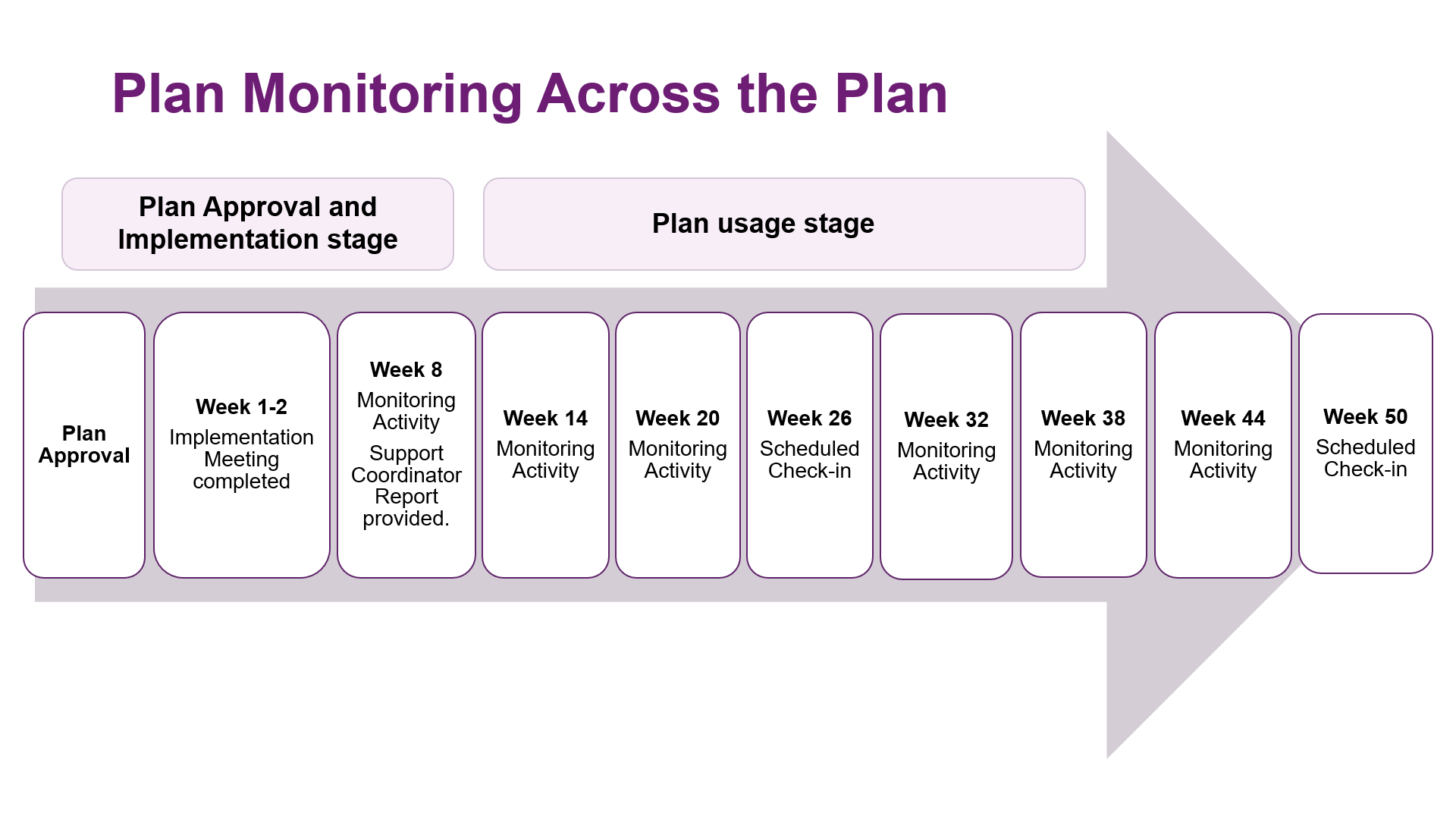
FOI 25/26-0078 - DISCLOSURE LOG
OFFICIAL
Appendix C
Stages of Monitoring and Check ins From Plan Approval
The diagram is a
timeline that outlines key activities during two main stages of a plan:
Image caption: A timeline outlining key activities from plan approval through to
implementation and ongoing monitoring activities, including scheduled check-ins and
monitoring milestones performed at regular intervals.
Note: The weeks displayed in the image above may not reflect the exact timeline within
PACE.
Stages Include:
1. Plan Approval and Implementation Stage
This initial phase spans the first eight weeks:
•
Weeks 1 to 2: The plan is formal y approved, and an implementation meeting is
conducted to initiate the process.
•
Week 8: A monitoring activity is carried out, and a report is submitted by the
Support Coordinator to assess early progress.
V2.1 2025-07-08
CSN Monitoring Framework
Page
21 of
22
OFFICIAL
Page 29 of 54
FOI 25/26-0078 - DISCLOSURE LOG
OFFICIAL
2. Plan Usage Stage
This phase covers the remainder of the plan's duration, from Week 14 to Week 50, and
includes regular monitoring and scheduled check-ins:
•
Week 14 and Week 20: Monitoring activities are conducted to track ongoing
progress.
•
Week 26: A scheduled check-in is held to review the plan's effectiveness and make
any necessary adjustments.
•
Week 32, Week 38 and Week 44: Additional monitoring activities are performed.
The later monitoring activities can be used to prepare the participant and
stakeholders with preparing for upcoming reassessment check-in.
•
Week 50: Dependent on length of plan a
Scheduled Check-in or Reassessment
Check-in is completed.
V2.1 2025-07-08
CSN Monitoring Framework
Page
22 of
22
OFFICIAL
Page 30 of 54
link to page 31 link to page 32 link to page 32 link to page 34 link to page 36 link to page 39 link to page 39 link to page 41 link to page 41 link to page 43 link to page 44 link to page 45 link to page 47 link to page 47
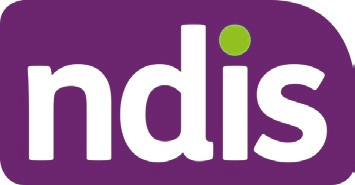
FOI 25/26-0078 - DISCLOSURE LOG
OFFICIAL
DOCUMENT 4
The contents of this document are OFFICIAL.
Complex Support Needs Branch (CSN)
Monitoring Work Instructions
Contents
Complex Support Needs Branch (CSN) Monitoring Work Instructions ........................................... 1
1.
Purpose ............................................................................................................................ 2
2.
Monitoring Activities .......................................................................................................... 2
3.
Actioning a Scheduled Check-in ....................................................................................... 4
4.
Creating a Discretionary Check-in .................................................................................... 6
4.1. System Generated Risk Flag Check-in ......................................................................... 9
5.
Creating an Enquiry (Planning and Monitoring cases) ...................................................... 9
6.
Best Practice for Caseload Management ....................................................................... 11
6.1. Recording Activities ..................................................................................................... 11
6.2. Creating a New Event ................................................................................................. 13
6.3. Setting Tasks .............................................................................................................. 14
6.4. Templates ................................................................................................................... 15
7.
Feedback ........................................................................................................................ 17
8.
Version Control ............................................................................................................... 17
OFFICIAL
V2.1
CSN Monitoring Work Instructions
2025-07-08
Page 1 of 18
Page 31 of 54
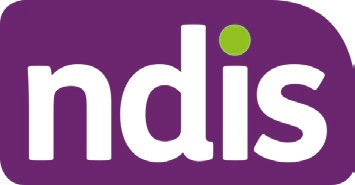
FOI 25/26-0078 - DISCLOSURE LOG
OFFICIAL
1. Purpose
Monitoring is a key component of the Complex Support Needs (CSN) Branch service offer. It is
essential that regular monitoring activities are completed during a participant’s journey in the
Complex Support Needs (CSN) Pathway.
This document should be read in conjunction with the Complex Support Needs Branch Monitoring
Framework document on CSN SharePoint,
CSN Service Model.
Monitoring activities can include:
• Initial contact with a participant when they enter the CSN pathway
• Implementation meetings
• Scheduled Check-ins
• Discretionary Check-ins
• Discretionary Check-in to determine suitability to transition to Service Delivery
• Desktop reviews
• 6 weekly monitoring activity
• Contact with the participant or their guardian/plan nominee
• Stakeholder engagement meetings
These work instructions will support CSN staff to complete the required monitoring activities and
inform enabling teams of the CSN monitoring process. These work instructions will support:
• Delegates, including CSN Planners, Resolution Officers
• Liaison Officers
• CSN Participant Support Officers (PSOs)
2. Monitoring Activities
A monitoring activity should reflect a task that undertakes a review of the current status of the
participant’s personal circumstances, situation, support systems and plan expenditure.
OFFICIAL
V2.1
CSN Monitoring Work Instructions
2025-07-08
Page 2 of 18
Page 32 of 54
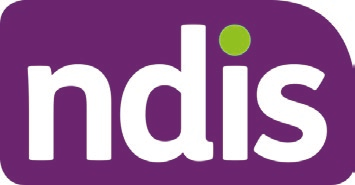
FOI 25/26-0078 - DISCLOSURE LOG
OFFICIAL
An email, phone call or a report from a participant, family member or service provider may result
in completing a monitoring activity or responding to certain requests. Information that is received
without a need for a response or action must still be recorded as a monitoring activity on PACE.
The below table outlines what is considered a monitoring activity and what is not considered a
monitoring activity:
Monitoring Activity
Not a Monitoring Activity
Initial contact at entry to CSN
Claim and Payment enquiries
Implementation Meeting
Internal escalation
Scheduled Check-in
Receive a quote
Support Coordinator Monitoring Report
Entering or recording ATHM and vehicle
modifications
Discretionary Check-in (Agency Initiated, Risk Creating a Request for Service (RFS)
Flagged and participant Initiated)
Desktop Review, including review of
Internal emails
documentation and reports from providers
Integrity and Compliance related tasks
Internal case consultation
(excluding internal contact)
Stakeholder Engagement meeting
Home and living application
Contact with participant or their guardian, plan Contact with participant and/or stakeholder/s
nominee regarding plan implementation and
for the purposes of obtaining information for
progress towards participant goals
plan review
OFFICIAL
V2.1
CSN Monitoring Work Instructions
2025-07-08
Page 3 of 18
Page 33 of 54
link to page 41
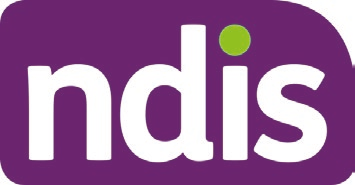
FOI 25/26-0078 - DISCLOSURE LOG
OFFICIAL
Monitoring Activity
Not a Monitoring Activity
Update to participant contact details including
address, email, bank account, etc
3. Actioning a Scheduled Check-in
A Scheduled Check-in is organised with the participant at an agreed time. The check-in frequency
and date are discussed with the participant, their plan nominee and/or Guardian and their
supports during plan approval or implementation meeting or at a previous Check-in. It is
recommended that a Scheduled Check-in occur 6 months after plan approval.
Check-ins are an important way we support participants and can occur at any stage of a
participant’s plan. During a Check-in you can:
• Talk with the participant to find out if they have made connections with the services and
supports they need.
• Ask how they are going with pursuing their goals and if there are any barriers to achieving
their goals.
• Ask if there have been any changes to their situation.
• Check if a Health Liaison Officer, Child Protection Liaison or a Justice Liaison Officer is
involved and reach out for an update prior to conducting the check-in.
To complete a Scheduled Check-in on PACE, follow the below instructions:
1. PACE will
auto-create a Check-in case 60 days before the Scheduled Check-in date (or
116 days if this is the last Check-in prior to the next plan re-assessment date). This Check-
in case wil be
automatically assigned to the CSN Planner.
2. When the Scheduled Check-in is assigned, contact the participant or authorised
representative and arrange a time to complete a Scheduled Check-in. All contact
(successful or unsuccessful contact attempts) must be recorded as an activity. Refer to
Section 6.1 for further information.
OFFICIAL
V2.1
CSN Monitoring Work Instructions
2025-07-08
Page 4 of 18
Page 34 of 54
link to page 43 link to page 41
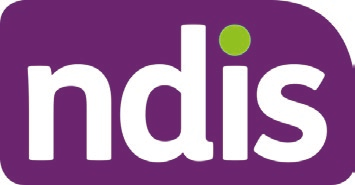
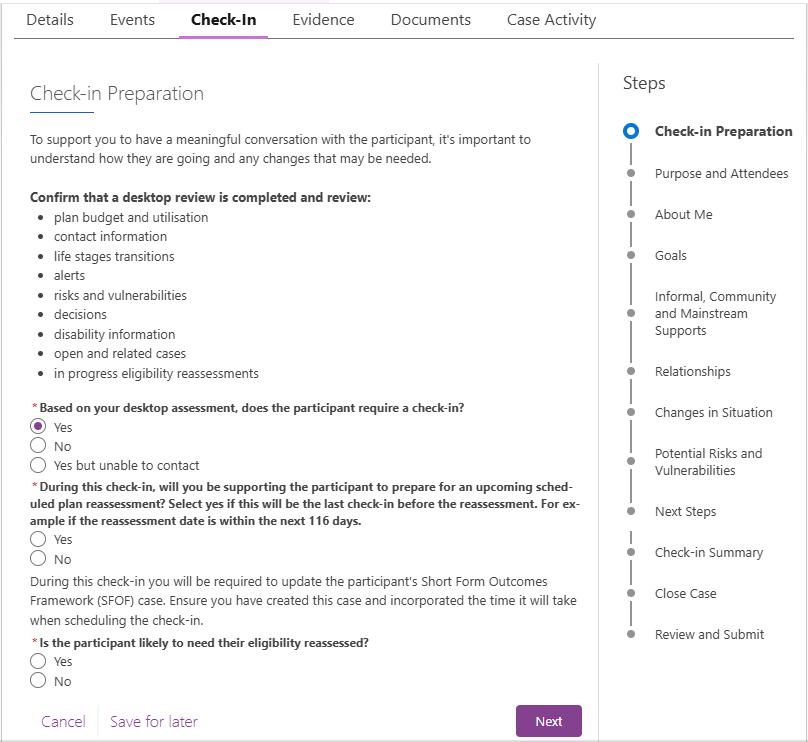
FOI 25/26-0078 - DISCLOSURE LOG
OFFICIAL
3. When you have confirmed with the participant their preferred date and time, record this as
a
New Event within the Check-in Case. Refer to
Section 6.2 for more information.
4. Complete the
Check-in preparation steps during your Check-in meeting.
5. Ensure all conversation details are recorded as an activity. Refer t
o Section 6.1 for more
information.
6. Complete next steps, Scheduled Check-in frequency to be set to
6 months, PACE will
automatically calculate the date.
OFFICIAL
V2.1
CSN Monitoring Work Instructions
2025-07-08
Page 5 of 18
Page 35 of 54
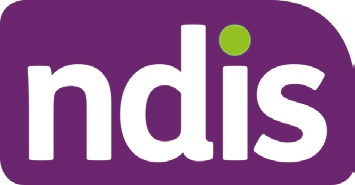
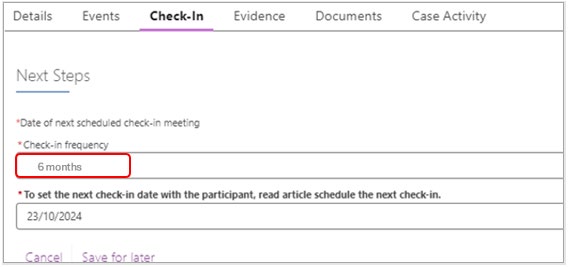
FOI 25/26-0078 - DISCLOSURE LOG
OFFICIAL
7.
Check-in Summary Letter is now Automatic:
Check-in Summary Letters are now automatically sent through the
Check-in Case as a
result of Release 25.1. These letters include information populated in the Check-in Summary
section of the
Check-in Case.
Please be mindful that textboxes populated on the Check-in Summary page within the
Check-in Case wil print on the Check-in Summary Letter.
Refer t
o Frontline Service Hub Check-in Case for more information.
4. Creating a Discretionary Check-in
Discretionary Check-ins can take place as needed and can be created at the staff members
discretion in response to an identified risk or vulnerability. Changes to a participant’s
circumstances may include moving home, breakdown of supports, changing providers, admission
to hospital or nearing release from a justice facility. If a staff member identifies a
welfare and/or
funding risk to the participant during a monitoring activity, they are required to create a
Discretionary Check-in case. This ensures that all relevant information is captured and recorded
appropriately and consistently.
A Discretionary Check-in plays an important role to safeguard participants to identify abuse and
neglect. It is an opportunity to sensitively talk about any risks or concerns with the participant.
OFFICIAL
V2.1
CSN Monitoring Work Instructions
2025-07-08
Page 6 of 18
Page 36 of 54
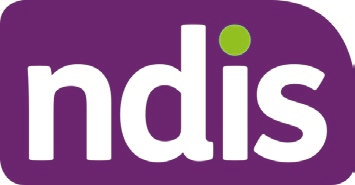
FOI 25/26-0078 - DISCLOSURE LOG
OFFICIAL
A Discretionary Check-in may come from an enquiry or during a 6-weekly monitoring activity,
where:
•
there are risks or concerns to talk about with the participant
•
the participant has questions or issues to discuss
•
there is a change in the participant's situation, or the participant has requested a change to
their plan.
You may also identify a risk or vulnerability, not automatically flagged in PACE .
To complete a Discretionary Check-in on PACE, follow the below instructions:
1. Select Check-in from new case option.
2. Select
Next. The
New Case: Check-in screen will display.
3. Use the default setting of
New at
Status.
4. Select an option from the
Reason Category dropdown and select Save.
5. Complete the Check-in preparation steps.
OFFICIAL
V2.1
CSN Monitoring Work Instructions
2025-07-08
Page 7 of 18
Page 37 of 54
link to page 41
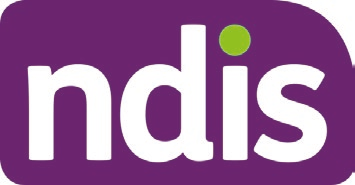
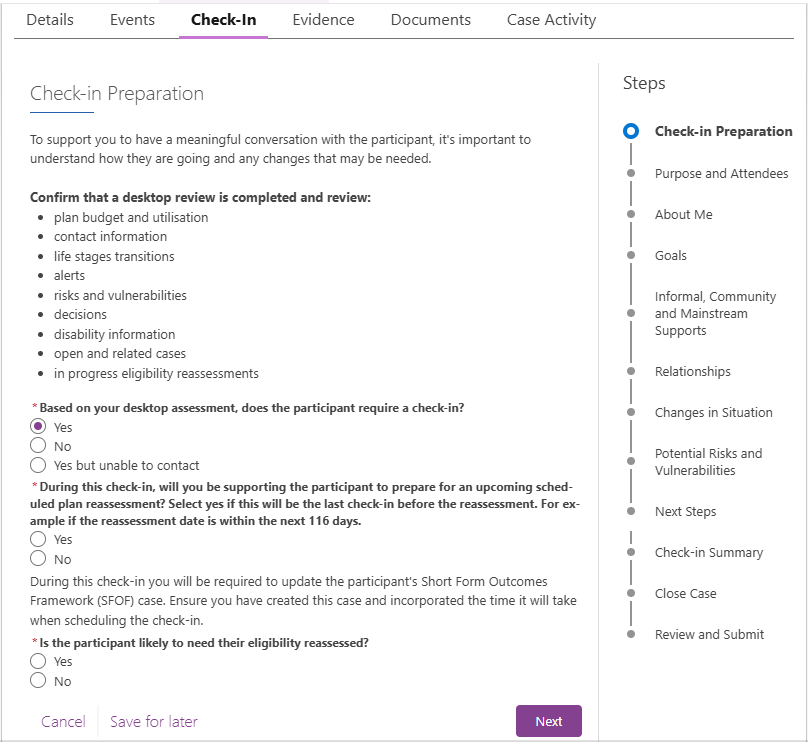
FOI 25/26-0078 - DISCLOSURE LOG
OFFICIAL
6. Ensure all conversation details are recorded as a case activity. Refer to
Section 6.1 for
more information.
7. Complete next steps, Check-in Frequency to be set to
6 months, PACE will automatically
calculate the date.
OFFICIAL
V2.1
CSN Monitoring Work Instructions
2025-07-08
Page 8 of 18
Page 38 of 54
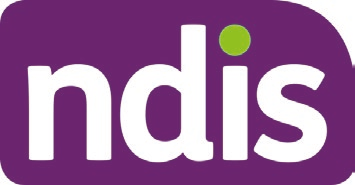
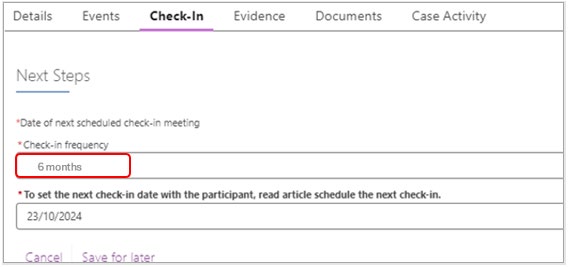
FOI 25/26-0078 - DISCLOSURE LOG
OFFICIAL
PACE will auto-create a Check-in case 60 days before the Scheduled Check-in date. This Check-
in case wil be automatically assigned to CSN Planner.
4.1.
System Generated Risk Flag Check-in
It is important to note that if a participant’s situation meets t
he risks and vulnerabilities criteria, a
system generated risk flag wil create an automatic Check-in case and will be assigned to the
CSN Planner, which is to be actioned within 7 days. For more information about system
generated risk flag Check-in case please refer to Knowledge Article
understand types of check-
ins.
5. Creating an Enquiry (Planning and Monitoring cases)
Monitoring is a key component of the CSN service offer. All staff across CSN are to be
consistently monitoring and recording tasks and activities of their engagement with participants.
The aim is to ensure that information is easily accessible, that all relevant staff understand the
participant’s situation and any further work required to support a participant.
To complete a monitoring enquiry case please follow the below instructions:
1. Select Create
Enquiry from new case option.
2. Select
Next. The
New Case:
Enquiry screen will display.
OFFICIAL
V2.1
CSN Monitoring Work Instructions
2025-07-08
Page 9 of 18
Page 39 of 54
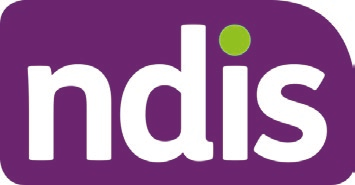
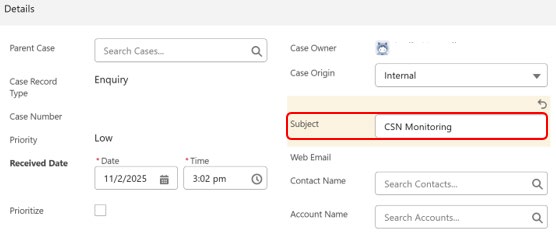


FOI 25/26-0078 - DISCLOSURE LOG
OFFICIAL
3. In the Subject line enter:
CSN Monitoring.
4. Add a description of the enquiry in
Enquiry Notes free text field.
5. From the drop-down options,
complete mandatory fields Requested by (who is making
the enquiry), and Case origin (how you received the enquiry).
6. Select the options that most closely match the enquiry from the
Category and
Subcategory drop-down lists. Select
Next.
OFFICIAL
V2.1
CSN Monitoring Work Instructions
2025-07-08
Page 10 of 18
Page 40 of 54
link to page 41
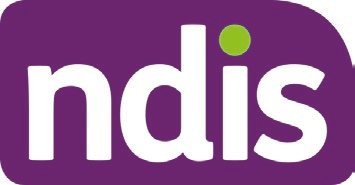
FOI 25/26-0078 - DISCLOSURE LOG
OFFICIAL
7. In the
Risk Matrix, select
Yes to see a list of risks and select all that apply. Otherwise,
select
No if there are no risks.
8. Follow
Next Action recommendations.
Next Action recommendations may include to
refer, resolve, or escalate the enquiry. Record all actions taken as activities in the
Activity
log. Refer t
o Section 6.1 for further information.
9. Select an
Enquiry outcome. Depending on the action you are taking, you can:
reassign
the case to another user or queue, select a
closure reason to close the case or keep the
enquiry open for
further action.
6. Best Practice for Caseload Management
6.1.
Recording Activities
Activities can be used within a case to note the details of a CSN staff members engagement
and/or activity, such as speaking to a participant, authorised representative, support coordinator
or responding to an email enquiry, actions taken or to be taken.
CSN monitoring activities can be recorded via a combination of check-in and/or enquiry cases.
Refer to Knowledge Article
log an activity or internal note for more information.
Activities enable easy review of information via the participant’s Account Timeline on their profile
page and provide a detailed view from the Account History. If an activity is not logged, then the
details of the Check-in case are only visible in the case itself. Activities are a helpful way to review
details of the monitoring and Check-in case.
(Note: activities cannot be used to collate data and are to assist you and others who may need to
access the file to details of the monitoring task).
1. In the case, locate the
Activity tab on the righthand side, select the
Log Activity.
OFFICIAL
V2.1
CSN Monitoring Work Instructions
2025-07-08
Page 11 of 18
Page 41 of 54
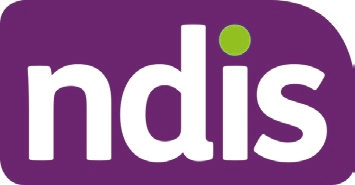

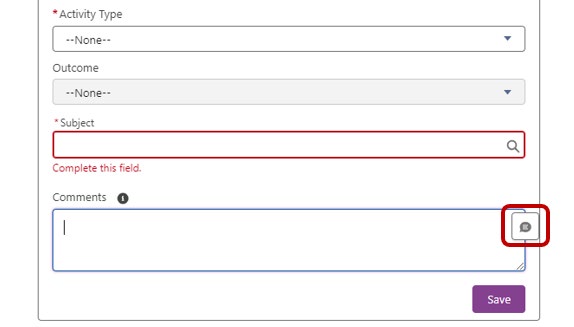
FOI 25/26-0078 - DISCLOSURE LOG
OFFICIAL
2. Select
Add to log a new activity.
3. Set the
Activity Type as required.
4. Select the
Subject as required.
5. Fil in the Comments field with key information. Templates can be accessed by selecting
the
Insert Quick Text Speech bubble on righthand side within the comments box.
6. Search
CSN to find CSN specific templates and select the most appropriate.
7. Fill in
template with required information. The use of templates is optional.
OFFICIAL
V2.1
CSN Monitoring Work Instructions
2025-07-08
Page 12 of 18
Page 42 of 54
link to page 44 link to page 44
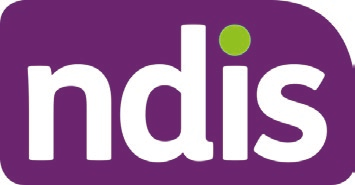
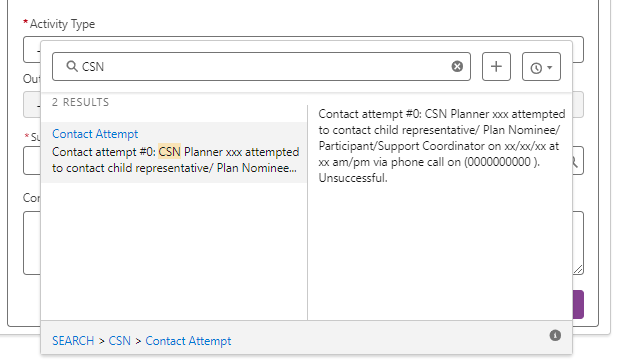
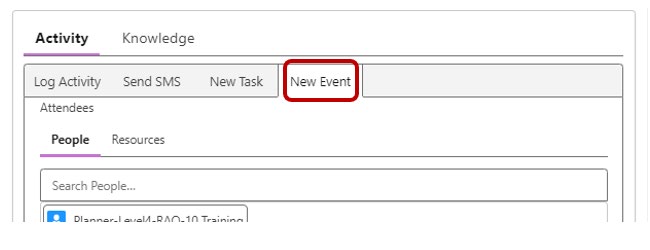
FOI 25/26-0078 - DISCLOSURE LOG
OFFICIAL
8. Select
Save.
9. Where required, set tasks for follow up actions including when your next monitoring activity
is required. Refer to
Section 6.3 for more information.
6.2. Creating a New Event
Events can be used by a CSN staff member to book and record upcoming events including
Scheduled Check-in meetings within a
Check-in case.
1. Select
New Event in the
Activity panel on the righthand side of the case.
2. Fil out the appointment details including date, time, subject and description.
3. Select
Save.
OFFICIAL
V2.1
CSN Monitoring Work Instructions
2025-07-08
Page 13 of 18
Page 43 of 54
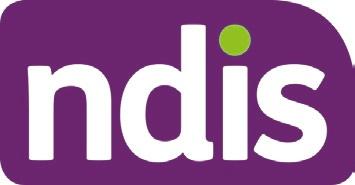
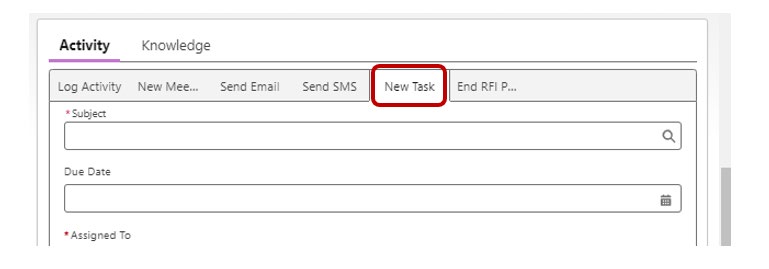
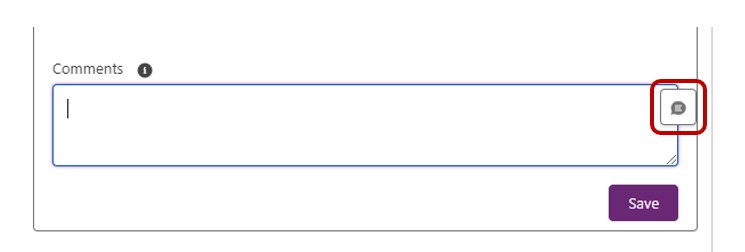
FOI 25/26-0078 - DISCLOSURE LOG
OFFICIAL
4. You will also need to send the participant or their authorised representative a calendar
invite if the meeting is through MS Teams. Communicate with the participant or their
authorised representative via their preferred method of communication.
6.3. Setting Tasks
Tasks can be used by CSN staff to monitor important dates and milestones and to ensure follow
up on any agreed actions or as a reminder to contact key stakeholders at the 6-week interval
between Scheduled Check-ins.
1. Within the case locate the
Activity tab under Milestones on the righthand side. Select
New
Task.
2. Add details of the task with key information including due date. Templates can be
accessed by selecting the
Insert Quick Text Speech bubble on righthand side within the
comments box.
3. Select
Save.
OFFICIAL
V2.1
CSN Monitoring Work Instructions
2025-07-08
Page 14 of 18
Page 44 of 54
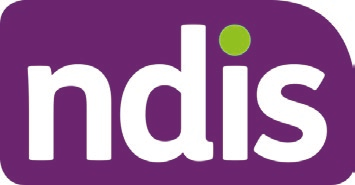

FOI 25/26-0078 - DISCLOSURE LOG
OFFICIAL
4. When the task is due, it wil show up in the notifications section. Click on the
bell icon on
the top right of the PACE homepage to view notifications. This should be checked daily to
monitor due tasks.
6.4. Templates
When completing a monitoring task, please use the most appropriate quick text template.
Topic
Context
Contact Attempt
Contact attempt [#0]: CSN Staff [name] attempted to
contact child representative/ Plan Nominee/
participant/Support Coordinator on [date] at [time] via
phone call on [phone number]. Unsuccessful.
Desktop Monitoring
CSN staff conducted desktop monitoring of [participant]
plan on [date]:
• [participants] plan has run for [#] months of its [#]-
month duration, of the [$ value] funding al ocated, [$
value] has been utilised.
• Core/ Relationships/ Behaviour Support/ Support
Coordination/ Improved Daily Living/ Home and
Living budget has been [over utilised /
underutilised].
• Transition from CSN is not considered at this time
due to [factors / barriers] / Transition from CSN is
considered appropriate at this time due to
[outcomes].
OFFICIAL
V2.1
CSN Monitoring Work Instructions
2025-07-08
Page 15 of 18
Page 45 of 54
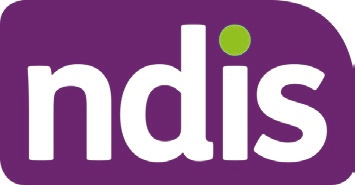
FOI 25/26-0078 - DISCLOSURE LOG
OFFICIAL
Topic
Context
• No further action required. Next Check in is
scheduled for [date].
Scheduled Check-in
CSN staff contacted [name] (Support Coordinator/Plan
Notes: include details
Nominee/Child Representative/Participant) at [time] on
such as date, time,
[date] via phone/email for Scheduled Check-in.
contact method,
Discussion points:
attendees and
• Engagement in community and or mainstream
accessibility
services.
requirements.
• Provided further information regarding mainstream
supports eg Housing/ Foodbank/ Lifeline/ General
Practitioner, Mental Health Care Plan.
• Currently engaged with or referral completed for
therapeutic service eg Occupational Therapist,
Speech Pathologist, Behaviour Support.
• Plan is currently over or underutilised due to [factors
/ circumstances].
• Any changes to the participant situation. Is a Plan
Change of Circumstances review required due to.
evidence discussed?
• CSN Staff advised of upcoming scheduled
reassessment on [date] and provided further
information on evidence required.
• Details confirmed and updated including Phone
Number, Address and Email.
OFFICIAL
V2.1
CSN Monitoring Work Instructions
2025-07-08
Page 16 of 18
Page 46 of 54
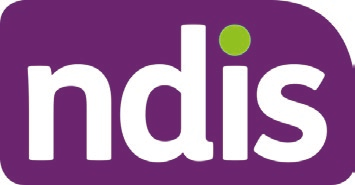
FOI 25/26-0078 - DISCLOSURE LOG
OFFICIAL
Topic
Context
• Transition from CSN considered.
• Any further questions or concerns raised.
• Any risks identified.
CSN staff advised of further check-in in 6-weeks. [name]
has CSN staff members details if questions or concerns
arise in the interim. No further action at this time or follow
up actions required.
Actions required:
• CSN staff member to send follow up email on [date].
• CSN staff member to contact [name/title] to discuss
[factors / circumstances].
• No further action required.
7. Feedback
If you have any feedback about these Work Instructions, please complete t
he Monitoring
Framework Feedback Form.
8. Version Control
Version Amended
Brief Description of Change
Status
Date
by
V2.1
QVERHJ Approved Version
APPROVED
2025-07-08
V2.0
QVERHJ Review of Draft version
DRAFT
2025-05-05
OFFICIAL
V2.1
CSN Monitoring Work Instructions
2025-07-08
Page 17 of 18
Page 47 of 54
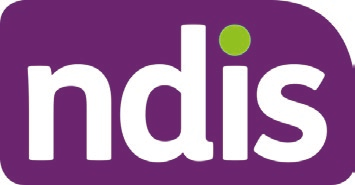
FOI 25/26-0078 - DISCLOSURE LOG
OFFICIAL
Version Amended
Brief Description of Change
Status
Date
by
1.0
GPO974 DRAFT version approved
DRAFT
2025-04-28
0.1
Initial Version
DRAFT
2025-02-06
OFFICIAL
V2.1
CSN Monitoring Work Instructions
2025-07-08
Page 18 of 18
Page 48 of 54
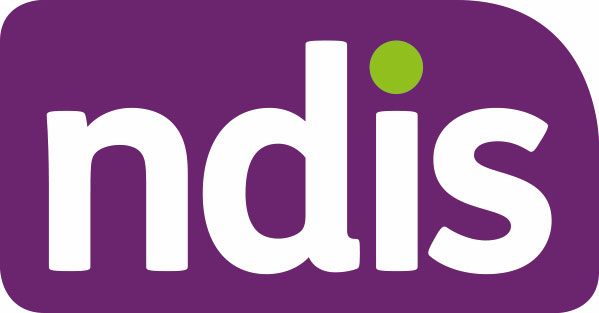
FOI 25/26-0078
FOI
- DISCLOSURE LOG
OFFICIAL
DOCUMENT 5
The contents of this document are OFFICIAL
Trauma Informed Approach Fact Sheet
Table of Contents
Trauma Informed Approach Fact Sheet .................................................................................... 1
What do I need to know? .......................................................................................................... 1
Trauma definition ................................................................................................................... 1
Exposure to trauma ............................................................................................................... 2
Traumatic events ................................................................................................................... 2
Effects of trauma ................................................................................................................... 2
Impact of trauma in the workplace ......................................................................................... 3
Trauma informed approach ................................................................................................... 3
What do I need to consider? ..................................................................................................... 4
What other information is relevant? .......................................................................................... 5
Support .................................................................................................................................. 5
Urgent Assistance ................................................................................................................. 5
Further learning ..................................................................................................................... 5
Further information ................................................................................................................ 5
The National Disability Insurance Agency (NDIA) is committed to providing a safe and mentally
healthy workplace. Everyone must take reasonable care for their own health and safety and
make sure they act in ways that do not affect the health and safety of others.
A trauma informed approach contributes to providing a safe and healthy workplace, one that is
inclusive and where everyone is treated fairly and respectfully. To apply a trama informed
approach, one must first have an understanding of trauma and the impacts of trauma.
What do I need to know?
Trauma definition
Trauma is an experience of extreme stress or shock to a traumatic event that may have been
life threatening involving actual or threatened exposure to death, serious injury or sexual
violence. Trauma can have lasting adverse effects on a person’s wellbeing and differs from
stress which is a common, and normal, response to new or challenging situations.
OFFICIAL
Trauma Informed Approach Fact Sheet
1
Page 49 of 54
FOI 25/26-0078 - DISCLOSURE LOG
OFFICIAL
Exposure to trauma
Trauma can happen to anyone. It is estimated that 75% of Australian adults have experienced a
traumatic event at some point in their life.
Different groups of people may experience different types of trauma, have different types of
responses, and the support they need can vary. This may include groups that are
disproportionately affected by trauma, for example, women and members of the LGBTIQA+
community.
Traumatic events
A traumatic event involves exposure to actual or threatened death, serious injury, or sexual
violence. Most people will go through at least one traumatic event in their lives. Traumatic
events can be single incidents or can occur over a long period of time.
Trauma can occur by direct experience, witnessing traumatic events, or prolonged exposure to
accounts of traumatic events.
Examples of traumatic events
Violence
Abuse
Death
Harassment
Sexual harassment
Discrimination
Assault
Sexual assault
Racist incidents
Natural disasters
Acts of terrorism
Acts of war
Serious illness
Serious health condition
Serious injury
Motor vehicle accidents
Displacement from family
Displacement from country of origin
Effects of trauma
Each person’s experience of, and response to trauma will be unique. Sometimes it can be hard
to make sense of what has happened or understand your feelings. This can be overwhelming
and difficult to articulate.
Effects of trauma can be complex and may include:
Emotional distress or detachment
Sadness
Anger or hostile behaviour
Fear, or worry about safety of self or others
Self-blame, guilt or shame
Slep
disturbance
Substance misuse or risk taking
Isolation
Self-harm
OFFICIAL
Trauma Informed Approach Fact Sheet
2
Page 50 of 54
FOI 25/26-0078 - DISCLOSURE LOG
OFFICIAL
Decline in physical or mental health
Changes to relationships or social functioning
Impair identity and self-worth
Effects on employment
Flash backs or helplessness
Elation at being alive or well
As experiences of trauma can impact on feelings of safety, this can contribute to challenges a
person faces when seeking help or support.
A range of reactions are normal and most people find they gradually feel better in the days and
weeks after the event. Sometimes these feelings or effects can resurface in the future.
Impact of trauma in the workplace
A person’s experience of trauma may not always be evident, and even where a person appears
to be managing well on a day to day basis, the impact of trauma can be triggered by anything at
any time including exposure to other unrelated incidents regardless of the severity.
For some people the impact of trauma can present in the work environment through
performance or behaviour concerns. This can can vary in severity or occurrence and may
include:
decrease
in
productivity
increased injury risk
workplace
absence
resignation
rehabilitation
costs
deterioration in work quality
high staff turnover
presentism
reputational
impact
external
jurisdiction
applications
breaches of work health and safety legislation
triggering effects of previous trauma.
It is important to note that these impacts don’t necessarily equate to a lived experience of
trauma, as these can occur in many other types of situations. However being open to the
possibility that trauma may be a factor can help with taking a supportive and empathic
approach.
Trauma informed approach
A trauma informed approach is a strengths-based framework which helps a person to feel safe,
collaboratively builds a supportive and trusted environment, whilst recognising that experiences
of trauma are common and can be experienced by anyone.
A trauma informed approach is founded on five core principles: safety, trustworthiness, choice,
collaboration and empowerment.
OFFICIAL
Trauma Informed Approach Fact Sheet
3
Page 51 of 54
FOI 25/26-0078 - DISCLOSURE LOG
OFFICIAL
Trauma informed practice involves:
a person-centric model of practice using interpersonal skills that convey empathy,
impartiality, safety, validation
recognising the signs and symptoms of trauma
understanding and recognising how trauma affects people, their needs, engagement
with others, and responses to situations
understanding and acknowledging how historical events, cultural safety, or other
diversity factors may also influence how trauma affects individuals
culturally respectful and responsive communication including tailoring your
communication accordingly
converying hope and identifying a person’s strengths to empower and support recovery
actively minimises re-traumatisation through providing choice and limiting need for re-
telling of traumatic expriences
acknowledging the importance of respect, dignity and hope
recognises that recovery from trauma is also possible with effective support
understanding that many individuals will choose self-help or community resources to
guide their own recovery.
What do I need to consider?
Trauma may be uncomfortable or distressing for some people. Not all individuals will feel
comfortable to disclose that they have experienced trauma.
Treat all circumstances and disclosures with compassion and care. It is important that
any discussions are done sensitively, safely, and confidentiality is maintained.
Consider your communication style including body language, tone of voice and language
to foster a safe, respectful and trusted environment.
Managers should consider flexibility to support employees and workers to balance their
family, personal and wellbeing commitments but also achieve their work outcomes.
Understand that sometimes impacted employees and workers may have trouble
managing their workload and may be distracted.
Managers should have conversations to understand individual circumstances and
needs. Every matter should be considered from it’s own unique perspective.
Managers should help their team member to consider and identify what supports might
be appropriate and explore these options.
Consider the workplace support options available for individual circumstances. You have
a choice on who to contact for support. The nature of your individual circumstances may
influence who the most appropriate person or team is that you choose to contact.
If you have experienced trauma or are supporting someone that has been impacted by
trauma, care for your own health and wellbeing. Visit the Well+ intranet page for useful
resources.
If symptoms of trauma are left unsupported they can worsen over time and have a
significant impact on day to day wellbeing. Getting help early can lesson the effects and
improve healthy recovery.
OFFICIAL
Trauma Informed Approach Fact Sheet
4
Page 52 of 54
FOI 25/26-0078 - DISCLOSURE LOG
OFFICIAL
What other information is relevant?
Support
If you have experienced trauma or are a manager supporting someone that has experienced
trauma, you can seek support from:
A
manager
Peer Support Contact Officer
Health and Safety Represntative
Early Intervention Team via the People and Culture Service Desk
Work Health and Safety Team
Safe and Respectful Team
Employee Assistance Programs
Urgent Assistance
If you or someone in your workplace is in crisis and immediate action is needed, contact the
following for support:
Emergency services – 000
Lifeline – 13 11 14
Suicide Call Back Service – 1300 659 467
13YARN - 13 92 76 (crisis support for Aboriginal and Torres Strait Islanders)
EAP (APS employees) – 1300 360 364
EAP (Labour hire workers) – EAP providers for Labour Hire Workers (DOCX 80KB)
All Work Health and Safety incidents, hazards and near misses must be reported
through Speak Up.
Further learning
To learn more about trauma, review the Australian Institute of Health and Welfare
information on Stress and trauma (aihw.gov.au).
To enhance your learning and help staff be aware of the possibility of trauma in
people accessing services, view/listen to Blue Knot Foundation video on Being
Trauma-Informed in the Workplace - YouTube.
To understand the use of recovery language, review the document Recovery Oriented
Language Guide (mhcc.org.au) produced by produced by the Mental Health
Coordinating Council (MHCC)
Further information on the NDIA’s Safe and Respectful Workplace is available on the Safe and
Respectful Workplace intranet page.
Further information
Related information can be found in the following documents:
NDIA Enterprise Agreement 2020-2023
Safe and Respectful Workplace Policy
OFFICIAL
Trauma Informed Approach Fact Sheet
5
Page 53 of 54
FOI 25/26-0078 - DISCLOSURE LOG
OFFICIAL
Procedure for Reponding to Sexual Harassment
Procedure for Responding to Bullying, Harassment and Discrimination
Work Health and Safety Policy
Family and Domestic Violence Policy
NDIA HR Delegations Matrix
Version control
HPE content
Version
Action
Approved
Date of
manager
control
approval
document no
TBC
V1.0
Sign off
Director People Support 26 May 2023
OFFICIAL
Trauma Informed Approach Fact Sheet
6
Page 54 of 54
Document Outline











































